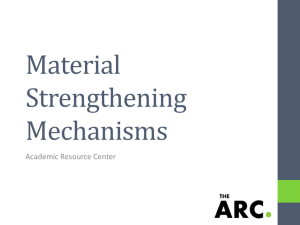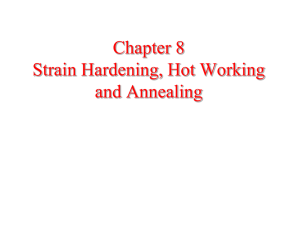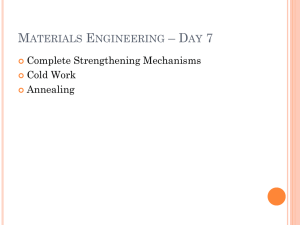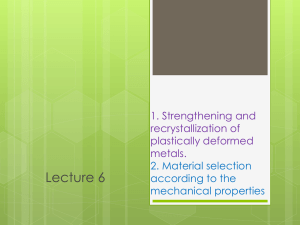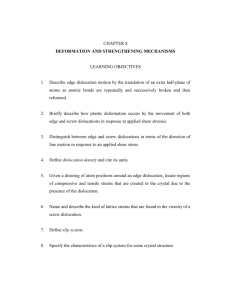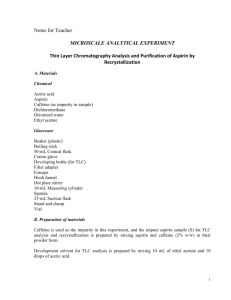L8_Properties_Heat treatment
advertisement
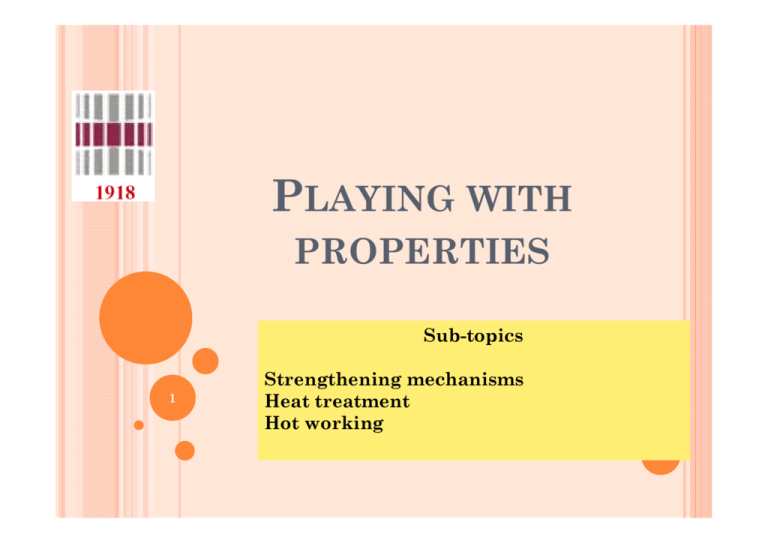
PLAYING WITH PROPERTIES Sub-topics 1 Strengthening mechanisms Heat treatment Hot working CAN SLIP PROCESS BE CONTROLLED? If the dislocation at point A moves to the left, it is blocked by the point defect. If the dislocation moves to the right, it interacts with the disturbed lattice near the second dislocation at point B. If the dislocation moves farther to the right, it is blocked by a grain boundary. Defects in materials, such as dislocations, point defects, and grain boundaries, serve as ‘‘stop signs’’ for dislocations. 2 MANIPULATING STRENGTH The way to strengthen crystalline materials is to make it harder for dislocations to move Materials: engineering, science, processing and design, 2nd edition Copyright (c)2010 Michael Ashby, Hugh Shercliff, David Cebon STRENGTHENING METALS By intentionally introducing substitutional or interstitial atoms, we cause solid-solution strengthening Increasing the concentration of the impurities results in an attendant increase in tensile and yield strengths Lattice strain field interactions between dislocations and impurity atoms result in dislocation movement restriction. copper-nickel alloys Why do alloys usually stronger than pure metals? 4 SOLUTION HARDENING Strengthening of a metal by alloying – deliberate additions of dopants Alloying elements are generally bigger than those of the host material, making it harder for dislocations to move Materials: engineering, science, processing and design, 2nd edition Copyright (c)2010 Michael Ashby, Hugh Shercliff, David Cebon THE EFFECTS OF ALLOYING ELEMENTS ON THE YIELD STRENGTH OF COPPER. 6 DISLOCATION-POINT DEFECT INTERACTIONS Point defect and dislocation will interact elastically and exert forces on each other. Solute atoms tend to diffuse to and segregate around dislocations in a way so as to reduce the overall strain energy, that is to cancel the strain in the lattice surrounding a dislocation • Vacancies will be attracted to regions of compression. • Interstitials will be collected at regions of tension. 7 SOLUTION HARDENING Representation of tensile lattice strains imposed on host atoms by a smaller substitutional impurity atom. Possible locations of smaller impurity atoms relative to an edge dislocation such that there is partial cancellation of impurity–dislocation lattice strains. Contribution of solid solution to the shear strength required to move the dislocation 8 SOLID-SOLUTION STRENGTHENING – SUBSTITUTIONAL ATOM 9 SOLID-SOLUTION STRENGTHENING – INTERSTITIAL ATOM 10 PROBLEM The lattice resistance of copper, like that of most FCC metals, is small. When 10% of nickel is dissolved in copper to make a solid solution, the strength of the alloy is 150 MPa. What would you expect the strength of an alloy with 20% nickel to be? The contribution of solid solution to the yield strength 11 DISPERSION AND PRECIPITATE STRENGTHENING If the solubility limit is exceeded, a different strengthening mechanism, dispersion strengthening, may come in to play. In dispersion strengthening, the interface between the host phase and guest phase resists dislocation motion and contributes to strengthening. Materials: engineering, science, processing and design, 2nd edition Copyright (c)2010 Michael Ashby, Hugh Shercliff, David Cebon PRECIPITATION HARDENING Representation of compressive strains imposed on host atoms by a larger substitutional impurity atom Particles obstruct the dislocation motion Possible locations of larger impurity atoms relative to an edge dislocation 13 such that there is partial cancellation of impurity–dislocation lattice strains. DISLOCATION MOVEMENT 14 SOLID-SOLUTION STRENGTHENING 15 STRENGTHENING MECHANISMS Brass – a copper rich copper – zinc alloy an increase in strength will often lower the ductility 16 DESIGN PROBLEM You have to produce a bracket to hold ceramic bricks in place in a heat-treating furnace. The bracket should maintain most of its strength up to 600 C. Design the material for bracket, considering various possibility to strengthen material. In order to serve up to 600oC, the bracket should not be produced from a polymer material. Instead, a metal or ceramic would be considered. 17 HOW TO MAKE AN ALUMINUM CAN. 18 ANNEALING PROCESSES The term annealing refers to a heat treatment in which a material is exposed to an elevated temperature for an extended time period and then slowly cooled. Ordinarily, annealing is carried out to (1)relieve stresses; (2)increase softness, ductility, and toughness; (3)produce a specific microstructure. Any annealing process consists of three stages: (1) heating to the desired temperature, (2) holding or ‘‘soaking’’ at that temperature, and (3) cooling, usually to room temperature. 19 ANNEALING Annealing is a heat treatment used to eliminate some or all of the effects of cold working. Annealing at a low temperature may be used to eliminate the residual stresses produced during cold working without affecting the mechanical properties of the finished part. Annealing may be used to completely eliminate the strain hardening achieved during cold working. In this case, the final part is soft and ductile but still has a good surface finish and dimensional accuracy. After annealing, additional cold work could be done, since the ductility is restored; By combining repeated cycles of cold working and annealing, large total deformations may be achieved. 20 RECOVERY The original cold-worked microstructure is composed of deformed grains containing a large number of dislocations Stored strain energy residual stresses During recovery, some of the stored internal strain energy is relieved by dislocation motion (in the absence of an externally applied stress), as a result of enhanced atomic diffusion at the elevated temperature some reduction in the number 21 of dislocations; and dislocation configurations are produced having low strain energies. RECRYSTALLIZATION Even after recovery is complete, the grains are still in a relatively high strain energy state. Recrystallization is the formation of a new set of strain-free and equiaxed grains that have low dislocation densities and are characteristic of the pre-cold-worked condition. The driving force to produce this new grain structure is the difference in internal energy between the strained and unstrained material. The new grains form as very small nuclei and grow until they completely replace the parent material. 22 Processes involve short-range diffusion. RECRYSTALLIZATION During recrystallization, the mechanical properties that were changed as a result of cold working, are restored to their pre-cold-worked values. The metal becomes softer, weaker, yet more ductile. Some heat treatments are designed to allow recrystallization to occur with these modifications in the mechanical characteristics. Recrystallization is a process, the extent of which depends on both time and temperature. 23 What temperature is needed for recrystallization? For pure metals, the recrystallization temperature is normally BRASS 0.3Tm, where Tm is the absolute melting temperature; for some commercial alloys it may run as high as 0.7 Tm. 24 RECRYSTALLIZATION TEMPERATURE The temperature at which a microstructure of new grains that have very low dislocation density appears is known as the recrystallization temperature. o The temperature at which recrystallization just reaches completion in 1 hour. 25 RECRYSTALLIZATION IN METALS The variation of recrystallization temperature with percent cold work for iron. For deformations less than the critical (about 5%CW), recrystallization will not occur. Rate of recrystallization increases with amount of cold work • require a critical amount of coldwork to cause recrystallization (5 - 40%) • recrystallization is easier in pure metals than in alloys and occurs at lower T: 0.3Tm versus ~0.7Tm • A smaller original cold-worked grain size reduces the recrystallization temperature; • Increasing the annealing time reduces the recrystallization temperature 26 Recrystallization temperature depends on many variables and is not a fixed temperature similar to melting temperature of elements and compounds. ANNEALING - RECRYSTALLIZATION IN METALS • Recrystallization can be exploited in manufacturing • Heating a metal to its recrystallization temperature prior to deformation allows a greater amount of straining. Lower forces and power are required to perform the process Schematic illustration of the effects of recovery, recrystallization, and grain growth on mechanical properties and on the shape and size of grains. 27 DESIGN PROBLEM A cylindrical rod of noncold-worked brass having an initial diameter of 6.4 mm is to be cold worked by drawing such that the cross-sectional area is reduced. It is required to have a cold-worked yield strength of at least 345 Mpa and a ductility in excess of 20%EL; in addition, a final diameter of 5.1 mm is necessary. Describe the manner in which this procedure may be carried out. 28 RECOVERY AND RECRYSTALLIZATION (SUMMARY) Recovery • occurs during heating at elevated temperatures below the recrystallization temperature • dislocations reconfigure due to diffusion and relieve the lattice strain energy • electrical and thermal properties are recovered to their pre-cold worked state Recrystallization • recrystallization results in the nucleation and growth of new strain-free, equiaxed grains • contain low dislocation density equivalent to the precold worked condition → annealed state • restoration of mechanical properties → softening 29 EFFECT OF ANNEALING ON MICROSTRUCTURE Cold worked After recovery After Recrystallization After grain growth Time is an important parameter in these procedures 30 GRAIN GROWTH Schematic representation of grain growth via atomic diffusion. After recrystallization is complete, the strain-free grains will continue to grow if the metal specimen is left at the elevated temperature Grain growth occurs by the migration of grain boundaries The driving force for grain growth. An energy is associated with grain boundaries. As grains increase in size, the total boundary 31 area decreases, yielding an attendant reduction in the total energy. FEATURES OF GRAIN GROWTH • Growth of new grains will continue at high temperature • does not require recovery and recrystallization • occurs in both metals and ceramics at elevated temperature • involves the migration of grain boundaries • large grains grow at expense of small ones • reduction of grain boundary area (driving force) 32 HOW LARGE ARE GRAINS? For many polycrystalline materials, the grain diameter d varies with time t according to the relationship time-independent constants the initial grain diameter At lower temperatures the curves are linear. Grain growth proceeds more rapidly as temperature increases. Why? The logarithm of grain diameter versus the33 => the enhancement of diffusion rate logarithm of time for grain growth in brass at with rising temperature. several T. HOT WORKING - BASIC 34 WHY HOT WORKING? Plastic deformation operations are often carried out at temperatures above the recrystallization temperature. The material remains relatively soft and ductile during deformation because it does not strain harden, and thus large deformations are possible. During hot working the material is continually recrystallized. 35 HOT WORKING – INDUSTRIAL APPLICATIONS The plastic deformation experienced by the metal as it is pulled through the die tends to increase hardness and reduce ductility. It takes a great deal of force to push solid metal through a die but if it's heated up close to its melting point it deforms more readily. It needs less force to extrude the metal when it's hot but the "extrudate," (the technical term for the material that has been extruded,) is not as strong as when it's been extruded cold. 36 CHARACTERISTICS OF THE HOT WORKING PROCESS No strengthening occurs during deformation => the amount of plastic deformation is almost unlimited. Hot working is well suited for forming large parts. Some imperfections may be eliminated or their effect minimized. The surface finish is usually poorer than that obtained by cold working. Oxygen may react with the metal at the surface => oxides formation => sometimes the protective atmosphere is needed. The dimensional accuracy is more difficult to control – elastic strain must be considered, since the modulus of elasticity is low at T of hot working. 37 STRUCTURE OF HOT-WORKED MATERIAL Hot rolling Recrystallization Deformed elongated grains If the hot working T is properly controlled, the fine product will have fine grain sizes. Grain growth 38 GRAIN STRUCTURE EVOLUTION THROUGH DEFORMATION AND ANNEALING Dislocations rearrangement New grains formation by migration of boundaries from a few sub-grain nuclei 39 Materials: engineering, science, processing and design, 2nd edition Copyright (c)2010 Michael Ashby, Hugh Shercliff, David Cebon HOT WORKING AND ANNEALING (SUMMARY) 40 HOT ROLLING 41 FORMABILITY Desirable material properties in metal forming: Low yield strength and high ductility → Any deformation operation can be accomplished with lower forces and power at elevated temperature 42 PROBLEM Design of a Process to Produce Copper Strip You have to produce a 0.1-cm-thick, 6-cm-wide copper strip having at least 414 MPa yield strength and at least 5% elongation. Only 6-cm-wide strips in thicknesses of 5 cm are available in the stock. Design a process to produce the product needed. 43 STEEL MAKING PROCESS http://www.youtube.com/watch?v=9l7JqonyoKA&feature=related 44
